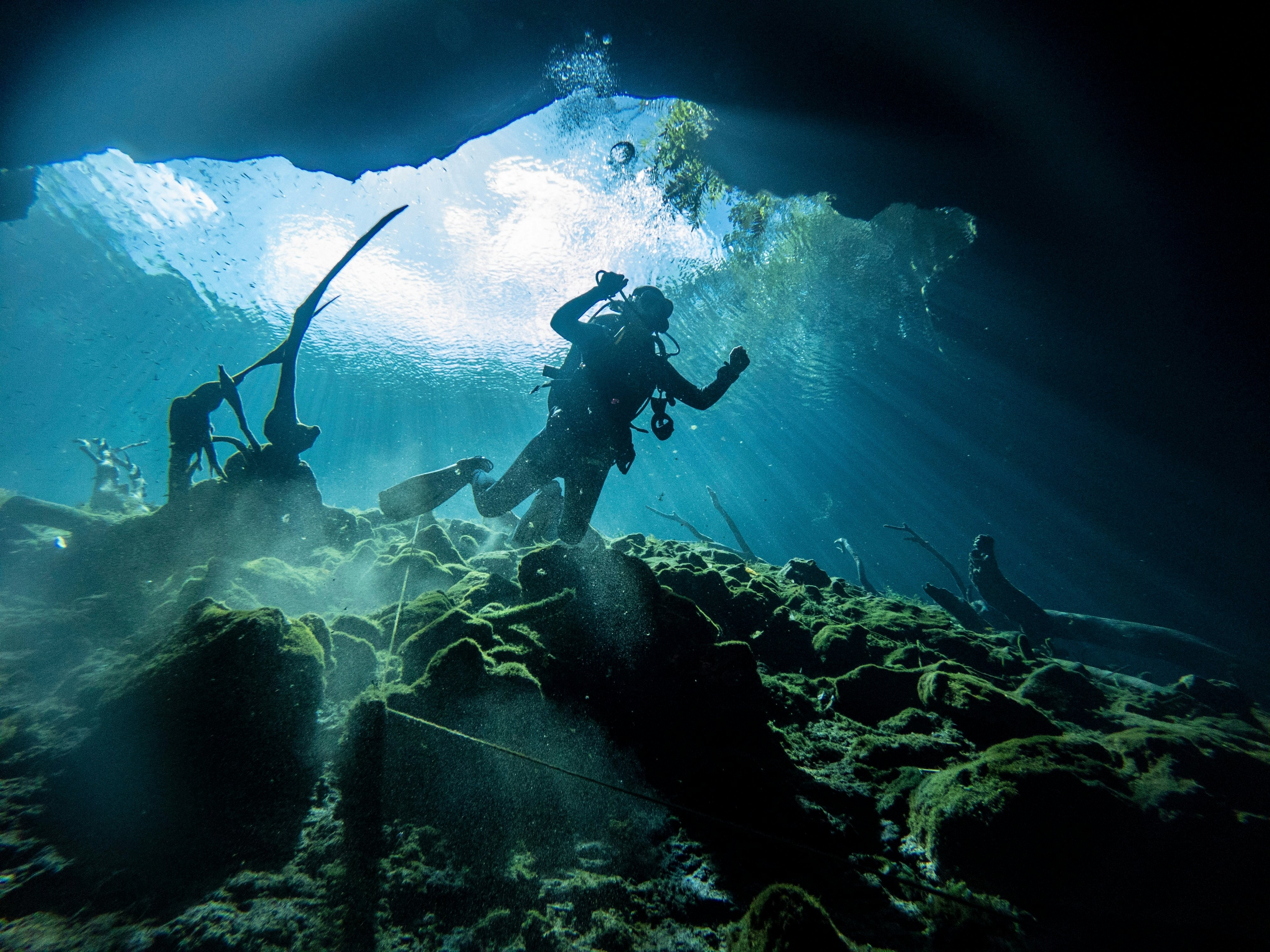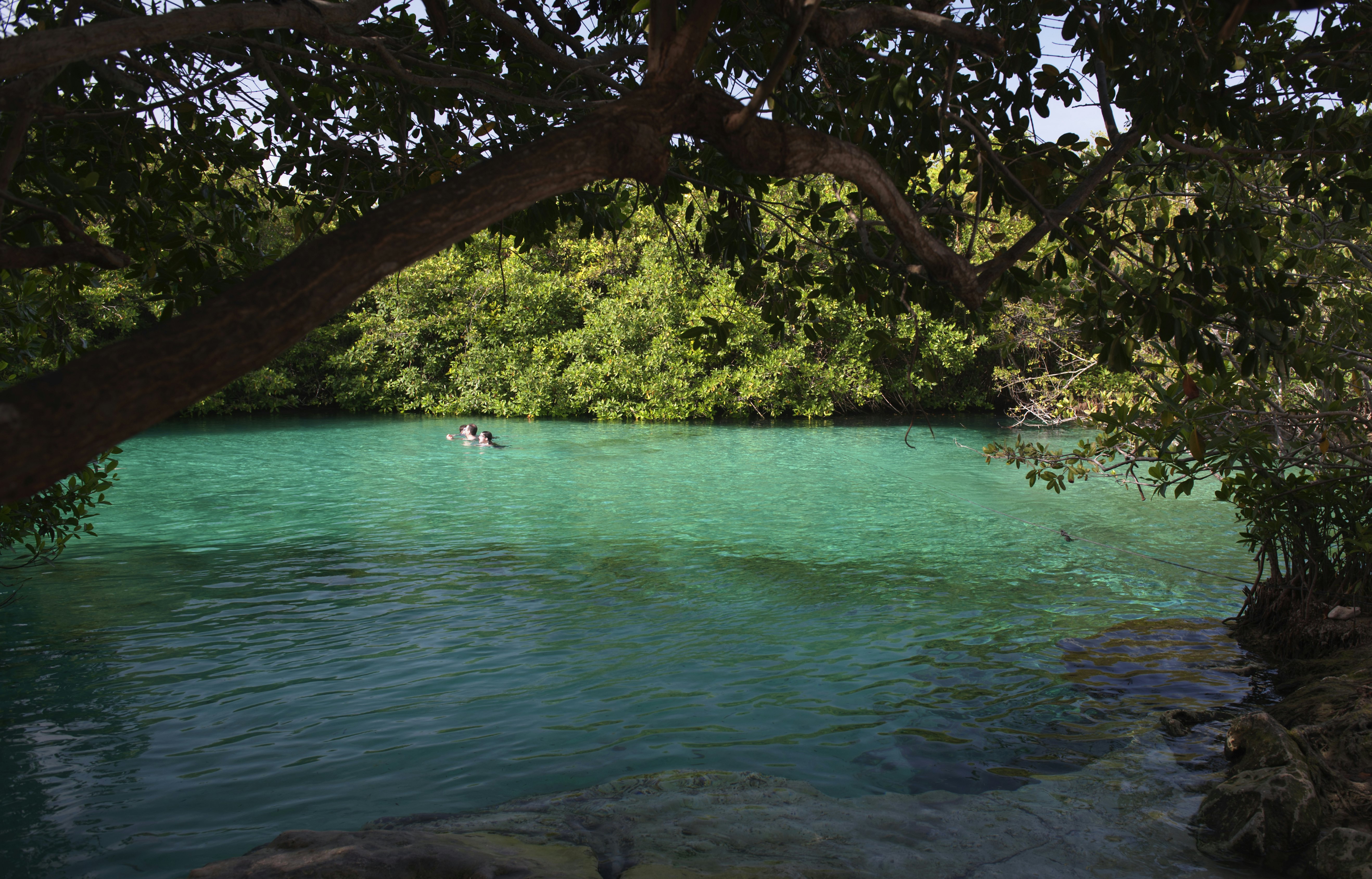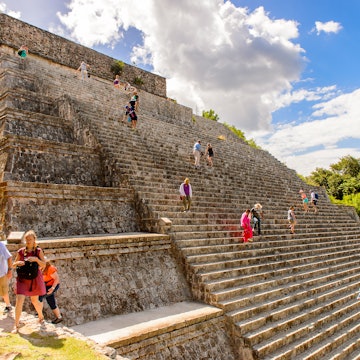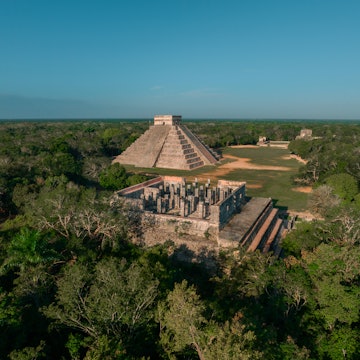

Plan your visits to Tulum's best cenotes with this guide. Nehuenpg/Shutterstock
Tulum is known worldwide for its idyllic white-sand beaches fringed with turquoise water and boho-chic party vibes. But there's more to Tulum than its shores. Cenotes – natural limestone sinkholes and underwater cave systems considered sacred by the Mayans – were formed over millions of years by the collapse of cave ceilings.
The Maya believed the crystal-clear pools to be a gateway between the underworld and the living, often used for offerings and rituals to honor gods and spirits.
An estimated 6000 cenotes are scattered across the Yucatán Peninsula, with several found in the vicinity of Tulum. These days, they’re easily accessible by renting a car, cycling or joining a tour.
And the best part: you’ll never run out of cenotes to explore. Some are tucked away in the verdant jungle surrounding the town, while others lie along the highway connecting Tulum with Cancún and the rest of the Riviera Maya.
There are three types of cenotes: open cenotes, which look like lakes and have the clearest water due to full exposure to sunlight; semi-open cenotes, partially covered caves that let in sunlight through natural holes; and closed cenotes, completely enclosed caves or ones with a small opening at the top, rich in stalactites and stalagmites.
If traveling with kids, consider water depth – some are shallower than others – and whether facilities are available nearby.
Here’s our guide to the best cenotes in Tulum.

1. Gran Cenote, near Tulum
Best for spotting turtles
Perhaps the most popular cenote near Tulum, Gran Cenote is well worth a visit, just make sure you do it early in the morning because it gets crowded quickly. It's close enough to town to arrive by bike, and the refreshing water covered in water lilies provides a nice welcome.
Underwater tunnels divide Gran Cenote into two areas. The first one is usually more crowded, but if you keep walking, you’ll find a more peaceful setting where you might spot turtles swimming in the clear turquoise waters.
A wooden staircase allows for easy access. Once in the water, make sure you look up at the vaulted cave ceilings, where you’ll catch a glimpse of bats napping in the shade.
Planning tip: Arrive early, as it’s a popular stop for tour buses from Chichén Itzá. Wearing a life vest is compulsory at Gran Cenote and most others, but you can rent one when paying the entrance fee. Consider wearing reef-friendly sunscreen, as the chemicals in regular sunscreen can damage the delicate ecosystems of cenotes.

2. Cenote Calavera, near Tulum
Best for those who love a party vibe
A mere two minutes away from Gran Cenote, you’ll find Cenote Calavera, also known as Temple of Doom. But don’t let the name deter you: it merely alludes to its shape. It features three openings – two eyes and a mouth cavity when seen from above – which, with a bit of imagination, resemble a calavera (a skull).
The widest of the three openings has a wooden staircase that takes you to the bottom and a makeshift rope swing for those after the most Insta-friendly snaps. The drop from the top of the smaller holes is quite deep, so you can safely jump in without worrying about hitting the bottom. Just don’t be surprised if the splash you cause sends bats flying out the hole.
There are pool chairs scattered around the rock floor, which means that it can get a little loud with chatter and – depending on the day and the vibe of the crowds – with music. Grab a drink and a bite from the on-site restaurant and join in on the fun.
Planning tip: It's best to visit early if you want the place to yourself. Unlike Gran Cenote, life vests aren’t compulsory here, but they’re available if you prefer to wear one.

3. Cenote Dos Ojos, along the highway between Tulum and Playa del Carmen
Best for diving or snorkeling
Part of Sac Actun, the largest flooded cave system in the world, Cenote Dos Ojos was one of the first cenotes to open to the public. Literally translated as "two eyes," it owes its name to the two pools of water that make it up, connected by a swimmable underwater tunnel, provided the tide is high enough.
While one of the two pools is ideal for swimming, snorkeling and diving in the crystal-clear water, the other has a mysterious air about it thanks to the bats living in the stalactites and stalagmites.
Planning tip: Cenote Dos Ojos is a 20-minute drive from Tulum. Alternatively, you can take a bus and rent a bike at the entrance to avoid the 30-minute walk along a dirt road under the punishing sun.

4. Cenote Nicte-Ha in Parque Dos Ojos
Best for avoiding the crowds
Located within Parque Dos Ojos, this wild cenote is very close to the popular Cenote Dos Ojos and shares the same entrance. Those after a quiet experience away from the crowds should follow the signs to Nicte-Ha, a small cenote nestled in the jungle and fringed by tree roots and rocks.
Once there, you can snorkel in the crystal-clear water accompanied by water lilies, turtles and colorful fish – and yes, the occasional tourist too; unfortunately, you won’t always have the place to yourself.
Be sure to bring drinking water with you, as there are no shops here, but you can rent a life vest on arrival and there are rustic facilities on site.
Planning tip: Take the same route as Cenote Dos Ojos, but allow for an extra 15-minute walk.

5. Cenote Encantado, near Sian Ka’an Biosphere Reserve
Best for those traveling with pets
The enchanted cenote Encantado has yet to be discovered by the masses. Its location near the Reserva de la Biosfera Sian Ka'an means fewer crowds and a diverse ecosystem that allows you to spot iguanas, racoons, crabs and other critters.
Explore this open cenote surrounded by mangroves via kayak. It's pet-friendly and equipped with a large platform where you can spend the day at leisure.
Planning tip: You’ll need to rent a car to get there.

6. Cenote Carwash, near Tulum
Best for diving pros
Cenote Carwash’s real name is Aktun-Ha, but it gained its nickname from a nearby car wash that used to be located on the premises.
This semi-open cenote is pretty pristine and is connected to the Zacil Ha cenote by an underground network. You can see submerged trees, aquatic plants, turtles and fish.The snorkeling area is about 5m-deep (16ft), while the cavern reaches a depth of 15m (49ft).
Planning tip: You'll need an authorized guide to dive the cave. If you go in the summer, you'll see algae turn the bottom of the cenote a vivid green.

7. Casa Cenote or Cenote Manatí, near Tulum
Best for diving or snorkeling beginners
Casa Cenote used to be known as Casa Manatí, given that manatees were a frequent sighting. Sadly, owing to the cenote's popularity with tourists, these slow-moving marine mammals have moved on.
Still, the cenote is worth a visit. It's less than half a mile from the Caribbean Sea, and you can witness the famous halocline – the point where freshwater and saltwater meet – at shallow depths. Kayak rentals are available here.
Planning tip: This cenote is 10km (6 miles) from Tulum, in the direction of Playa del Carmen. You can get there by car or bike.

8. Laguna Nopalitos, near Tulum
Best for kids
Opened to the public in 2020, Laguna Nopalitos remains off international tourists’ radars. This natural sanctuary got its name from a unique feature – a dark shadow in the center of the freshwater lagoon that resembles the shape of a nopal leaf. The shadowy depths of an underwater cenote cause this cactus-like shape.
Shallow waters and a long dock where you can sit and dip your feet in are part of the draw, and much like the peninsula's largest and more famous lagoon, Laguna de Bacalar, the water here is multicolored, with three distinct shades of blue depending on the depth.
You can spend the whole day here, and thanks to shallow waters and well-appointed facilities, it’s great for those traveling with kids.
Planning tip: Hire a car or take a taxi; the drive is around 30 minutes from Tulum.
















